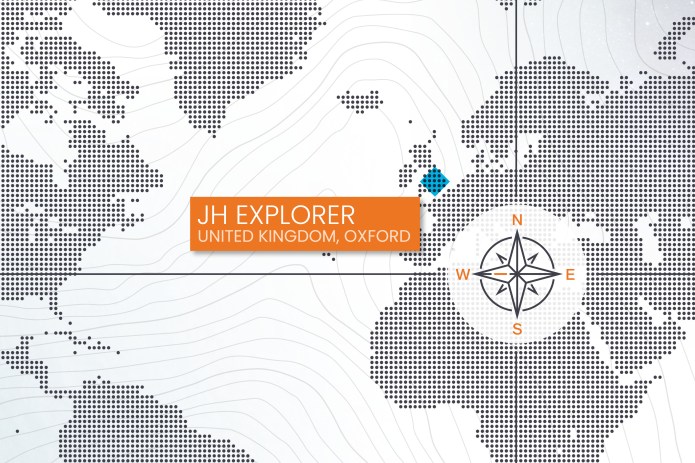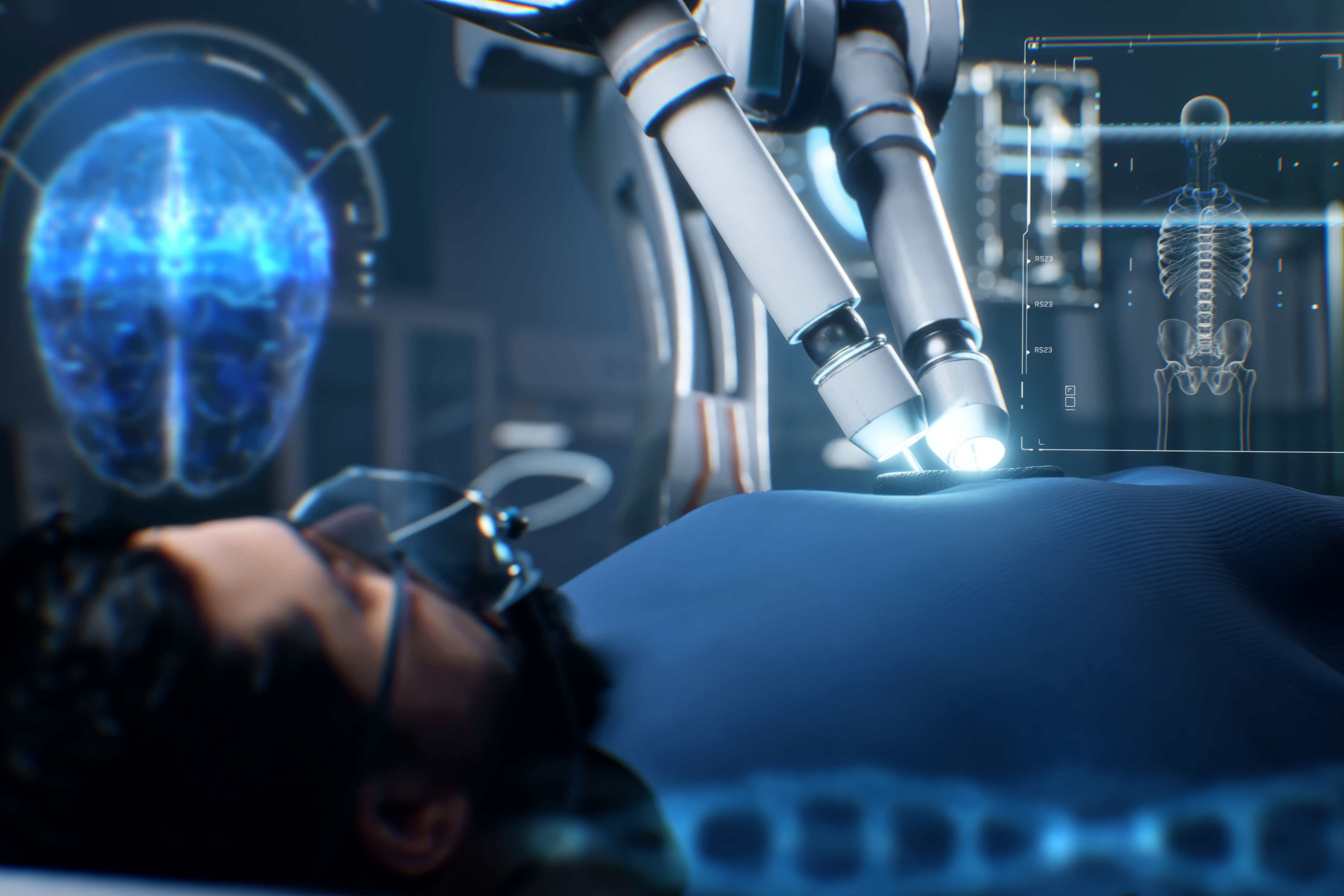JH Explorer in Oxford: Insights into tech-enabled robotic surgery
Kimberley Pavier, Sustainability Analyst in the Global Technology Leaders Team, visits Intuitive Surgical, a leader in robotic surgery, to find out more about their latest innovation, as well as the company’s improving sustainability efforts.

4 minute read
Key takeaways:
- Technological innovation is providing solutions to global healthcare challenges, such as improved outcomes, accessibility, safety and quality of life.
- With new technology comes risks and opportunities. Health tech companies like robotic surgery provider Intuitive Surgical offer attractive growth prospects with a focus on sustainable operations.
- The team is enthused about how accelerated compute power is being utilised by the new Da Vinci 5 system and is reconvinced of ISRG’s competitive advantages. Monitoring and engagement is key to help strengthen the company’s sustainability case.
A leader in robotic-assisted surgery
Intuitive Surgical (ISRG) has been a dominant player for many years in the highly innovative area of robot-assisted medical procedures. ISRG aims to enhance patient and surgeon outcomes, educate the surgical community and is an advocate for improved healthcare outcomes and access – therefore it maps to our health tech theme. With poverty and inequality rising as a result of an expanding and ageing population, these challenges require technological innovation like ISRG’s, employing artificial intelligence (AI) and data analytics to enable access to quality healthcare, improved outcomes, and improving safety and quality of life.
Great example of ‘technology for good’ in health tech
Da Vinci is a robotic arm system, controlled by the surgeon using a console, with multiple instruments, accessories and add-ons like staplers, as well as extensive software. The surgical system works by bringing together computational, robotic, and imaging technologies, showcasing how technology can be used for good. During a visit to ISRG’s facility in Oxford, I was able to trial the Da Vinci Xi and Si systems. I was pleasantly surprised by its smooth navigation, how sensitive and responsive it was, and the incredible response time. It was easy to understand how the robot would cause less trauma to the body while operating compared to a surgeon’s hands. Via the training console the instructor could draw, point and write on the screen, with enhanced vision and audio making it easy for surgeons to learn from best-in-class peers to enhance and improve their skills. I was also shown the new ION diagnostics tool, which showcased ISRG’s ability to expand beyond surgical equipment. This technology is minimally invasive and can detect cancer much earlier.

On this visit I wasn’t shown the latest and most advanced Da Vinci 5 system, but the team is very excited about its capabilities and potential. With 10,000 times the compute power of the previous system, Da Vinci 5 will continue to evolve with more software, more AI and machine learning in surgery. The new system includes ‘force feedback’ technology, providing the ability to measure and sense the push and pull forces at the instrument tip. This can help reduce tissue trauma, with surgeons noting up to 43% less force on tissue. Da Vinci 5 also has the most realistic 3D imaging, with four times more pixels, better colour and resolution. This is a huge leap for robotic surgery enabled by technology.
We think ISRG is a true technology robotics company, and in the long term, could provide many insights for improving surgery, enabling the skills of the best surgeons in the world to be passed on.
Improving sustainability case
My visit also complemented and informed the team’s analysis of ISRG’s sustainability credentials. We think the company is strong on social and governance factors, including its product quality, innovation, extensive network, analytics and training ecosystem, which builds out the competitive moat, supported by a strong management team.
The largest environmental footprint can be found in ISRG’s supply chain, where we encourage more stewardship. Within design and manufacturing, the most material environmental factors are found in the equipment use phase – single-use plastics, single/multi-use instruments (that need to be replaced) and sterilisation chemicals, as well as end of life waste management.
While we see this as an area for improvement, there is positive momentum through initiatives such as the “Extended Use Program” and their announcement of a future climate transition plan. As active managers, we can engage with management on these areas.
Overall, I returned from my visit enthused by the developments in robotic surgery and diagnostics, and it also reinforced our team’s views on ISRG’s competitive advantages. While improvements are needed in terms of disclosures and its environmental focus, we gained a better idea of ISRG’s ESG footprint, sustainable impact and improving sustainability case.
These are the views of the author at the time of publication and may differ from the views of other individuals/teams at Janus Henderson Investors. References made to individual securities do not constitute a recommendation to buy, sell or hold any security, investment strategy or market sector, and should not be assumed to be profitable. Janus Henderson Investors, its affiliated advisor, or its employees, may have a position in the securities mentioned.
Past performance does not predict future returns. The value of an investment and the income from it can fall as well as rise and you may not get back the amount originally invested.
The information in this article does not qualify as an investment recommendation.
There is no guarantee that past trends will continue, or forecasts will be realised.
Marketing Communication.
Important information
Please read the following important information regarding funds related to this article.
- Shares/Units can lose value rapidly, and typically involve higher risks than bonds or money market instruments. The value of your investment may fall as a result.
- Shares of small and mid-size companies can be more volatile than shares of larger companies, and at times it may be difficult to value or to sell shares at desired times and prices, increasing the risk of losses.
- If a Fund has a high exposure to a particular country or geographical region it carries a higher level of risk than a Fund which is more broadly diversified.
- The Fund is focused towards particular industries or investment themes and may be heavily impacted by factors such as changes in government regulation, increased price competition, technological advancements and other adverse events.
- The Fund follows a sustainable investment approach, which may cause it to be overweight and/or underweight in certain sectors and thus perform differently than funds that have a similar objective but which do not integrate sustainable investment criteria when selecting securities.
- The Fund may use derivatives with the aim of reducing risk or managing the portfolio more efficiently. However this introduces other risks, in particular, that a derivative counterparty may not meet its contractual obligations.
- If the Fund holds assets in currencies other than the base currency of the Fund, or you invest in a share/unit class of a different currency to the Fund (unless hedged, i.e. mitigated by taking an offsetting position in a related security), the value of your investment may be impacted by changes in exchange rates.
- When the Fund, or a share/unit class, seeks to mitigate exchange rate movements of a currency relative to the base currency (hedge), the hedging strategy itself may positively or negatively impact the value of the Fund due to differences in short-term interest rates between the currencies.
- Securities within the Fund could become hard to value or to sell at a desired time and price, especially in extreme market conditions when asset prices may be falling, increasing the risk of investment losses.
- The Fund could lose money if a counterparty with which the Fund trades becomes unwilling or unable to meet its obligations, or as a result of failure or delay in operational processes or the failure of a third party provider.


